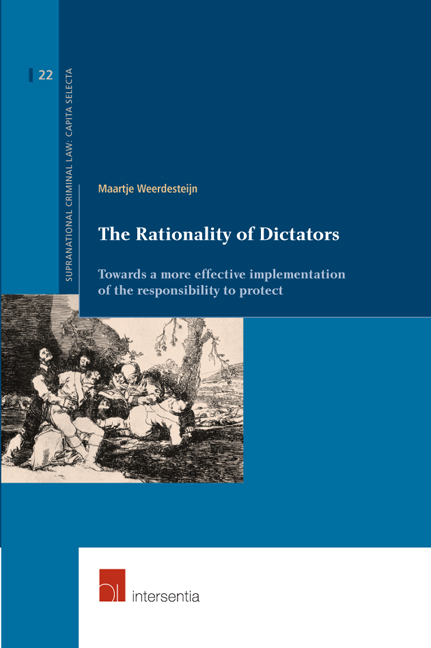 The Rationality of Dictators
The Rationality of Dictators Book contents
- Frontmatter
- Acknowledgements
- Contents
- Chapter 1 Introduction
- Part I The Theory
- Part II The Comparative Case Study
- Chapter 7 Pol Pot and the Destruction of Cambodia
- Chapter 8 Milosevic and the Dissolution of Yugoslavia
- Chapter 9 The Rationality of Pol Pot
- Chapter 10 The Rationality of Milosevic
- Chapter 11 Military Intervention: Lessons Learned from the Wars with NATO and Vietnam
- Chapter 12 Lessons Learned for the Implementation of the Responsibility to Protect
- Chapter 13 Conclusion: A Piece of the Puzzle
- References
Chapter 12 - Lessons Learned for the Implementation of the Responsibility to Protect
from Part II - The Comparative Case Study
Published online by Cambridge University Press: 28 September 2018
- Frontmatter
- Acknowledgements
- Contents
- Chapter 1 Introduction
- Part I The Theory
- Part II The Comparative Case Study
- Chapter 7 Pol Pot and the Destruction of Cambodia
- Chapter 8 Milosevic and the Dissolution of Yugoslavia
- Chapter 9 The Rationality of Pol Pot
- Chapter 10 The Rationality of Milosevic
- Chapter 11 Military Intervention: Lessons Learned from the Wars with NATO and Vietnam
- Chapter 12 Lessons Learned for the Implementation of the Responsibility to Protect
- Chapter 13 Conclusion: A Piece of the Puzzle
- References
Summary
INTRODUCTION
While the previous chapter investigated two case studies that played out before the responsibility to protect was developed and adopted by states, overarching lessons about the manner in which the ideology of a non-democratic leader influences his decision-making process, can be relevant for the future implementation of the responsibility to protect.
As was explained in Chapter 4, the third pillar of the responsibility to protect expressed the preparedness of states to intervene, under Chapter VII of the UN Charter if need be, to protect the population from genocide, war crimes, crimes against humanity and ethnic cleansing when the state in which the crimes occurs is unwilling or unable to do so. Frequently, as we have seen in previous chapters, when mass atrocities have occurred in non-democratic regimes, the dictator actually has orchestrated the violence. He has incited the crimes, legitimized them and formed the institutions that perpetrated the crimes. Under those circumstances, when the dictator plays such a crucial role, intervening under the third pillar often means that the international community needs to persuade the dictator to stop the perpetration of atrocities.
Within the framework of the responsibility to protect and Chapter VII of the UN Charter, peaceful measures are preferred over force in order to achieve the objective, but military intervention should be considered as a last resort. What are the lessons that can be drawn from the interventions in Cambodia and Kosovo for the manner in which the responsibility to protect should be implemented and what implications does it have for the manner in which we study dictators and their rationality? Are these interventions success stories? These are the questions that will be asked and answered in the present chapter.
Firstly, the different choices each of the dictators made will be explained from the perspective of Weber's two types of rationality. Secondly, the rationality of the decision will be differentiated from that of the dictator who took the decision and it will be analysed what role mistakes and misperceptions played in the decision-making process.
- Type
- Chapter
- Information
- The Rationality of DictatorsTowards a more effective implementation of the responsibility to protect, pp. 349 - 364Publisher: IntersentiaPrint publication year: 2016


